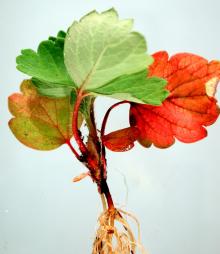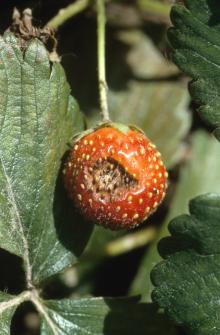Cause Several Colletotrichum spp. can cause various anthracnose diseases of strawberry. C. acutatum has been found by the OSU Plant Clinic. This is now considered a species complex where C. nymphaeae predominates on strawberry and C. fioriniae is less frequently found. The diseases of fruit and crown rot were not a problem in the 1900s but were found more often in 2000s. This may be due to newer, more susceptible cultivars and/or the introduction of these fungi into the region. The cultivars Albion, Puget Reliance, and Sweet Bliss are susceptible.
Plants may be infected in the nursery, show no symptoms and transported to production fields. The fungus may also survive in infected plants and plant debris in perennial fields. Small infections on those plants sporulate under very warm (greater than 68°F), wet, rainy conditions and spread quickly to other plants. Spores are rain splashed from infected to healthy plants. Young leaf petioles are more susceptible to infection than older petioles. Open flowers and ripening fruit are also very susceptible. Conditions in the PNW are generally much cooler than 68°F. Between 40°F and 50°F the fungus will survive in plants causing few symptoms. Continuous wet periods of 8 hours or more favor disease development. High nitrogen fertility also favors disease development.
Symptoms All parts of the plant may be infected and show symptoms. Lesions on stolons and petioles begin as small, red streaks and rapidly develop into dark, sunken, firm, elongate lesions. In humid, not wet, conditions pink spore masses may be seen in lesions. Petiole lesions may girdle the stem causing the leaf to wilt and die. Petiole lesions may also extend into the crown causing that to rot. Under high inoculum conditions, some cultivars will show a leaf spot but this has not been common in the PNW. Spots are small and round with black or gray centers.
Crown rot may first be detected by the wilting of the entire plant during hot weather. The youngest leaves may appear to recover but eventually the whole plant dies. Cutting the crown open reveals a reddish-brown firm rot or a reddish-brown streak. (Note that crowns will normally begin to redden after being cut and exposed to oxygen for several minutes in the absence of any fungal infections.) The discolored rot will generally begin on one side or portion of the crown.
Fruit rot, also called black spot, is common in the PNW and starts as light-brown, water-soaked spots on ripening fruit. These spots rapidly develop into firm, round lesions that turn dark-brown to black. Lesions may be covered with pink to orange colored spores under humid conditions. The fruit remains firm and eventually dries up to a hard mummy. But in most cases the fruit is invaded by a whole host of other organisms and rots quickly. On green fruit, the fungus may only invade an individual achene, which turns black and slightly sunken. Flowers may also blight back before forming any fruit.
Cultural control
- Use certified plants only.
- Space plants so foliage dries rapidly after rain and irrigation.
- Use drip irrigation if possible. When using overhead irrigation, shorten sets and water at times that promote rapid drying of the foliage.
- Use optimal fertilization.
- Remove and destroy infected fruit from the field.
Chemical control Focus on cultural control tactics. Use during flowering to manage fruit rot. Alternate or tank-mix products from different groups that have different modes of action. Limit the use of any one group during crop production. Selection of products for rotation and/or mixing must consider FRAC 7 fungicides when used through the irrigation as a nematicide. Resistance to FRAC 11 fungicides has been documented in Florida and was shown to be stable even in the absence of the chemical. A temperature- and leaf wetness-based disease warning system is available to help time applications.
- Abound at 6 to 15.5 fl oz/A. Do not apply with silicone-based surfactants. May be applied on the day of harvest. Group 11 fungicide. 4-hr reentry.
- Affirm WDG at 6.2 oz/A. Can be used in structures but not open fields. Group 19 fungicide. 4-hr reentry.
- Cabrio EG at 12 to 14 oz/A. May be used at harvest. 12-hr reentry.
- Cannonball WG at 2.5 to 4 oz/100 gal water applied as drip after harvest and washing of planting stock. 12-hr reentry.
- Captan 80 WDG at 3.75 lb/A. May be applied up to the day of harvest. Group M4 fungicide. 24-hr reentry.
- Inspire Super at 16 to 20 fl oz/A. Can be applied day of harvest. Group 3 + 9 fungicide. 12-hr reentry.
- Luna Sensation at 4 to 7.6 fl oz/A. May be use day of harvest. Group 7 + 11 fungicide. 12-hr reentry.
- Merivon at 5.5 to 8 fl oz/A. Do not use with EC or oil-based products. May be used day of harvest. Group 7 + 11 fungicide. 12-hr reentry.
- Miravis Prime at 11.4 to 13.4 fl oz/A. May be used day of harvest. Group 7 + 12 fungicide. 12-hr reentry.
- Pristine at 18.5 to 23 oz/A. Can be used day of harvest. Group 7 + 11 fungicide. 12-hr reentry.
- Propiconazole-based fungicides are registered. May be applied day of harvest. Group 3 fungicides.
- Bumper 41.8 EC at 4 fl oz/A. 12-hr reentry.
- Tilt at 4 fl oz/A. 24-hr reentry.
- Quadris Top at 12 to 14 fl oz/A plus a surfactant. May be applied on the day of harvest. Group 3 + 11 fungicide. 12-hr reentry.
- Regev at 4 to 8.5 fl oz/A. Do not apply within 2 days of harvest. Group 3 + BM01 fungicides. 12-hr reentry.
- Rhyme at 7 fl oz/A used through a drip system. May be used day of harvest. Group 3 fungicide. 12-hr reentry.
- Spectracide Immunox Multi-Purpose Fungicide Spray Concentrate for Gardens at 1.25 fl oz/gal water. May be applied up to the day of harvest. Do not apply more than six (6) times per season. Group 3 fungicide. H
- Switch 62.5 WG at 11 to 14 oz/A. May be used up to and including the day of harvest. Do not replant treated areas to anything other than crops listed on the label for 1 year after last application. Group 9 + 12 fungicide. 12-hr reentry.
- Topguard EQ at 5 to 8 fl oz/A. Do not use with silicone surfactants. May be applied on the day of harvest. Sprayers should not be used on apples. Group 3 + 11 fungicide. 12-hr reentry.
- Vacciplant at 14 to 22 fl oz/A plus an effective fungicide. Can be used day of harvest. Unknown efficacy in the PNW. Group P4 fungicide. 4-hr reentry.
Note: Some registered products offer only suppression of this disease and thus are not recommended for use. These products include Oso, Regalia and Topsin.
Biological control
- Serenade OPTI (Bacillus subtilis strain QST 713) at 14 to 20 oz/A. Active ingredient is a small protein. 4-hr reentry. O
Reference Dowling, M., Peres, N., Villani, S., and Schnabel, G. 2020. Managing Colletotrichum on fruit crops: A "complex" challenge. Plant Disease 104:2301-2316.



